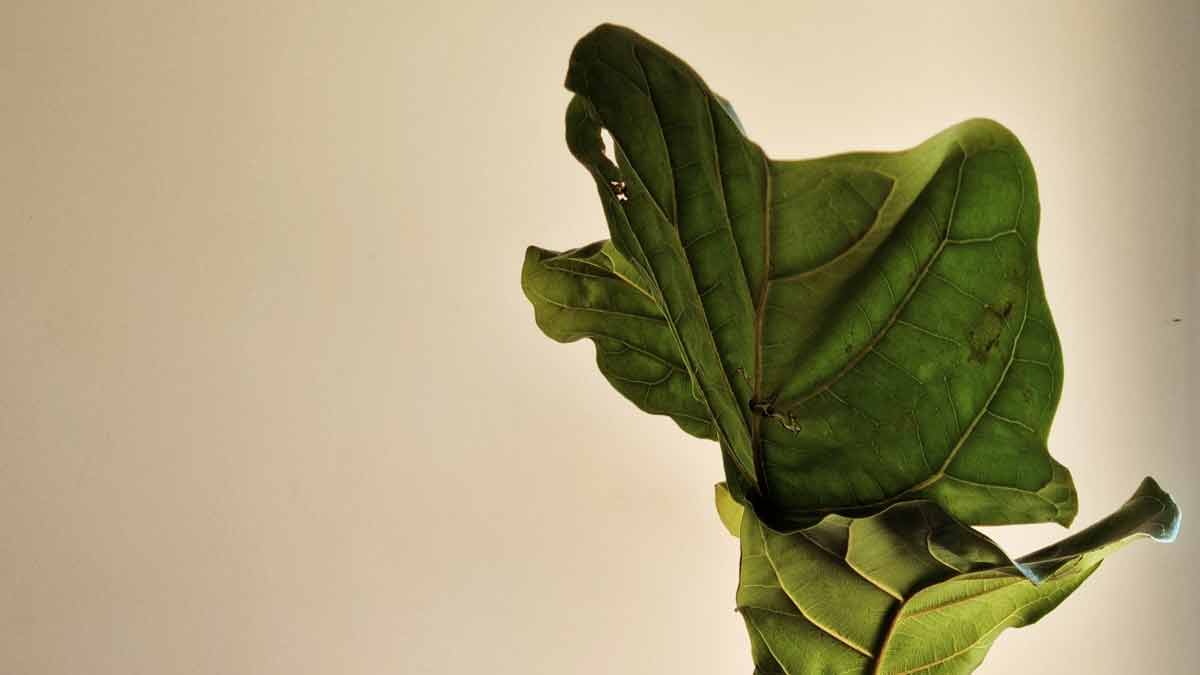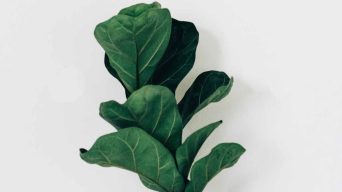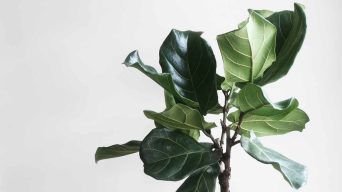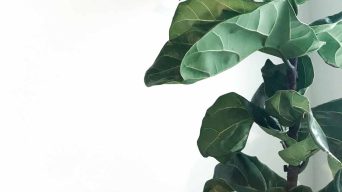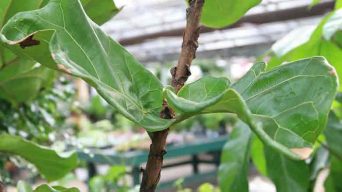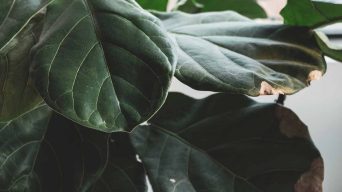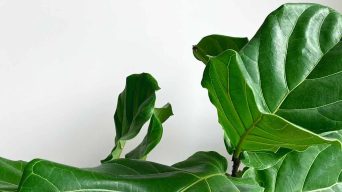Holes in the leaves of a fiddle leaf fig can be caused by various factors, including low humidity, pest infestations, and physical damage. Keep an eye on the humidity levels and inspect the plant for any signs of pests. Also, try to minimize any physical damage to the leaves to prevent holes from forming.
Holes in your fiddle leaf fig leaves can be a puzzling and concerning issue for you as a plant owner.
Fiddle leaf figs (Ficus lyrata) are an increasingly popular houseplant known for their eye-catching, large leaves that range in color from deep green to yellowish-green.
However, one issue you may encounter with your fiddle leaf fig is the appearance of holes in its leaves.
Holes in your plant’s leaves can be caused by various factors, from environmental issues to pests. Here you will find everything you need to know about holes in fiddle leaf fig leaves, including common causes and solutions you can try at home.
Understanding What to Expect from Healthy Fiddle Leaf Fig Leaves
Describe the characteristics of healthy fiddle leaf fig leaves and what to look for as signs of a problem.
Healthy fiddle leaf fig leaves can vary significantly in shape and size, but they will always be smooth or slightly waxy. They should have rich, dark green coloration with a glossy sheen that you can see when you look at them in the right light.
It’s normal for the leaf edges to curl inward or outward, but you shouldn’t see any holes or tears in them.
If you see holes in your fiddle leaf fig plant, it’s a sign that something is wrong, and you should look closer to determine the cause.
What Causes Holes in Fiddle Leaf Fig Leaves?
Fiddle leaf fig leaves can develop holes due to various factors. Here are the four most common causes you should look out for.
Insect Damage
One possible cause of holes in your fiddle leaf fig plants is insect damage.
Aphids, mealybugs, fungus gnats, and scale are some of the pests you may find on your plant, as they feed on its sap and tender new growth. These insects can cause irregular holes or scalloped edges in your plant’s leaves.
If you suspect you have an insect infestation, you should take steps to control and manage it as soon as possible.
Some simple solutions you can try are spraying the leaves with a water-dish soap solution or neem oil, wiping off any visible pests you see, or introducing beneficial insects to your plant.
Physical Damage
Another potential cause of fiddle leaf fig holes is physical damage. This may include accidental cuts, scratches, or punctures you make while pruning the plant or handling it.
It’s important to be gentle when caring for your fiddle leaf fig and always use clean, sharp tools for any pruning you need to do.
Nutrient Deficiencies
Fiddle leaf plants can develop leaf holes due to nutrient deficiencies, so they must receive their proper nutrients and minerals.
Boron, Zinc, and Copper are common nutrient shortages that lead to tissue necrosis. However, you can easily supplement the nutritional needs of your fiddle leaf fig by applying a well-balanced liquid fertilizer.
Insufficient Humidity
A lack of humidity around the fiddle leaf fig can also cause holes in its leaves. Fiddle leaf figs prefer high humidity, ideally around 40 to 60 percent.
If you suspect your plant’s environment is too dry, you can increase the humidity around it by misting the leaves regularly or setting up a humidifier near the plant.
A pebble tray with water can also help you increase humidity. To do this, you need to place a tray of pebbles underneath your fiddle leaf fig pot and fill it with enough water to reach the top of the stones.
Root Rot
Root rot can also cause holes in your fiddle leaf fig’s leaves. This usually occurs when you overwater the fiddle leaf fig, and it prevents the roots from absorbing nutrients and moisture.
An overwatered plant will usually show yellowing and wilting leaves, as well as small black spots or holes in the plant leaves.
If you notice these symptoms, you should check the roots for any signs of rot, such as browning or mushiness. If you find root rot, you’ll need to repot your fiddle leaf fig in fresh, well-draining soil and ensure you’re not overwatering it.
You can also use a fungicide to help prevent further damage from root rot.
How To Fix Fiddle Leaf Fig Holes in Leaves
Once you’ve identified the cause of the holes in your fiddle leaf fig leaves, you can take steps to fix them. Here are some tips you can use for various types of issues:
Isolate the Plant
If you’re dealing with an infection or infestation, the best way to start is by isolating the plant. Move it away from other plants and ensure you don’t let any affected leaves fall onto other growing plants.
Isolating the plant will help you contain the issues and prevent you from spreading it to other plants.
Use Neem Oil or Soap
If you’re dealing with an insect infestation, you can use neem oil or soap to get rid of them. Neem oil is a natural insect repellent that will kill any existing bugs on your plant and prevent new ones from coming by.
You can also use a mild soap solution to spray the leaves, which will help you eliminate any bugs you’re seeing on your plant.
Increase Humidity
If you’re seeing holes in your fiddle leaf fig leaves and think it’s due to dryness, you can increase the humidity around the plant.
You can place the pot in a pebble tray with water. This will help you maintain higher humidity levels around the plant and prevent further damage from occurring.
Trim Roots and Aerate Soil
If you see holes in the leaves due to root issues or a lack of oxygenation, trim any overgrown roots and aerate the soil.
Using gardening tools like pruners, you can trim any long roots. You should also use a garden fork to aerate the soil and give it more oxygenation, which will help ensure that your plant gets enough nutrients.
Replace Soil
If you’re dealing with an infection or insect infestation, you should consider replacing the old soil with a new one.
Fresh soil will help you eliminate any fungal or insect issues you’re seeing. Be sure to discard the old soil, as you don’t want to spread these issues to other plants.
Fertilize the Plant
Finally, you should consider fertilizing your plant. Fiddle leaf figs need plenty of nutrients for optimal growth, so you should feed them with a balanced liquid fertilizer at least once a month.
Be careful not to over-fertilize, as you don’t want to burn the leaves or cause further damage.
Preventing Holes in Fiddle Leaf Fig Leaves
Fiddle leaf fig care can be tricky, and you may find yourself dealing with issues like holes in your fiddle leaf fig leaves.
However, you can prevent these problems from occurring by following a few simple tips.
Proper Watering
Be sure you’re giving your fiddle leaf fig the right amount of water. Too little will cause dryness, while too much can lead to root rot.
Check the soil regularly and only water when it feels dry, at least one inch down into the potting mix. You should also consider using a moisture meter to help you check the soil moisture accurately.
Create a Humid Environment
Fiddle leaf figs love humid environments, so you should mimic their natural habitat as much as possible.
You can place your plant in a pebble tray with water or set up a humidifier near the plant. These simple measures will help you replicate the humid environment fiddle leaf figs need for optimal growth.
Check for Pests Regularly
Pests can cause severe damage to your plants, so you want to check them regularly and take steps to prevent infestations.
Look out for any signs of insects on the leaves or in the soil, such as whiteflies or mealybugs. If you spot any of these bugs, you should take action to eliminate them right away.
Follow a Regular Fertilization Schedule
Fiddle leaf figs need plenty of nutrients to thrive, so you should fertilize them regularly. You can use a balanced liquid fertilizer or a slow-release granular fertilizer at the beginning of each growing season.
Don’t over-fertilize your plant, though, as this can cause more problems than it solves.
Repot as Needed
You should repot your ficus lyrata every two to three years if you want it to stay healthy and happy. This is because potting soil can become compacted over time, inhibiting root growth.
When repotting the plant, you should use fresh, nutrient-rich soil to boost your fiddle leaf fig.
Add Drainage Holes to Pot
When repotting your fiddle leaf fig, ensure the pot you use has drainage holes. This will help you avoid overwatering and root rot, as excess water can easily escape.
You can always drill some in yourself if you need a pot with drainage holes.
Keep Out of Reach of Children and Pets
To prevent accidental damage, you should keep your fiddle leaf fig out of reach of children and pets.
Place it in an area where it won’t be disturbed, and you won’t have to worry about accidental damage.
Also, you should avoid handling your plant too much, as this can cause the leaves to become damaged or discolored.
Monitor Temperature and Light
Fiddle leaf figs need the right temperature and amount of light to stay healthy.
You should keep them in an area that gets bright indirect sunlight and where temperatures don’t drop below 60°F or exceed 90°F.
Avoid placing them near heat sources or drafty areas, as these can cause the leaves to dry or scorch.
You should also avoid too much direct sunlight, which can sunburn the fiddle leaf fig and cause yellowing or brown spots on the leaves.
Final Thoughts
Taking the time to inspect your fiddle fig is a great way to ensure it remains healthy.
If you notice any holes in the leaves, you can take preventative action to stop them from spreading further.
From proper watering and fertilizing techniques to pest control, you can ensure you are doing everything possible to keep your fiddle leaf fig looking its best.
With some care and attention, you can have a beautiful plant you can be proud of!

